
The best litter for cats is one that is
- sustainably produced,
- safe for both cats and humans,
- economical and lightweight,
- not too dusty,
- does not track (much),
- has odor control properties,
- is soft enough for declawed and post-surgery cats,
- changes color upon use to indicate possible sickness,
- flushable,
- is certified organic,
- biodegradable, and
- compostable.
Admittedly, what we’ve described is more like the ‘Ideal Cat Litter’. But hopefully, you can refer to the attributes as a checklist when choosing the best litter for your cat and your household.
You can click the links in the list above to get to any particular section you desire.
Or Read About Our First Choice in This Regard
1. Sustainably Produced Cat Litter
We can rule out clumping clay litter since that contains sodium bentonite. Bentonite clay is procured through ‘strip mining’ – an invasive procedure that leaves the land barren. For more information, you can read this post.
The hazards from this practice are even more pertinent today since the UN Food and Agriculture Organization has warned that at the current rate of soil degradation, we will likely run out of 90 per cent of farmable land by 2050.
For every other litter, even if it appears to have been ‘safely’ sourced from plants or trees, please check the official website or the product description to see how forthcoming the manufacturer is about the process of production.
For example, this is sWheat Scoop’s product description (we added the highlight):

This is the best we got for ‘secondary wheat’ when searching online for an answer:

So we asked them, through the contact email mentioned on their official website. They never replied to our query about what they mean by ‘100% secondary wheat’ and how it is renewable.
At best, we can assume their response team (which might also be their customer service) is not top-notch.
Also, their official website proudly mentions their collaboration with plasticbank:
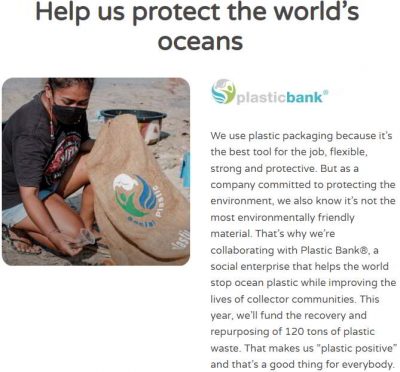
But when it comes to the manufacturing process, all we are told is that their wheat is farm grown and renewable.
To be clear, we’d still recommend sWheat Scoop. User reviews indicate it is, indeed, a very good litter. But for us to list it as sustainably produced litter, we’d have to see something like this:

Or this:
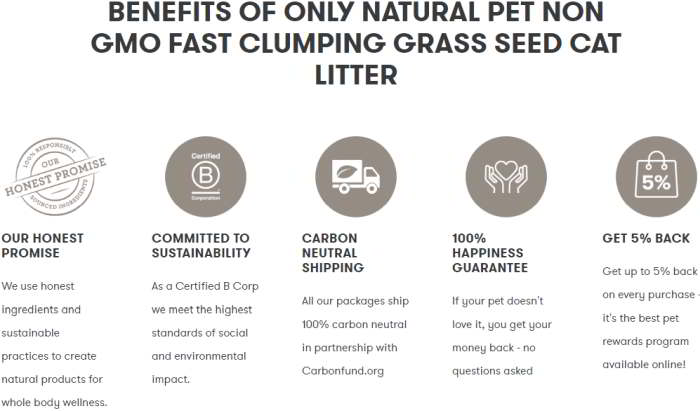
Especially when the footer of the site has links to details about what B Corp means, their own B Corp Score and more verifiable details about their efforts at saving the environment.
Summing it up: if you are serious about buying cat litter from an eco-friendly brand and the product description page is not clear enough, do visit the manufacturer’s website just to make sure.
2. Safe Cat Litter
A process of elimination will help us here. Instead of dwelling on what’s a safe litter for cats and humans alike, let’s consider what isn’t.
- Any litter that contains sodium bentonite – usually advertised on the merit of its ‘superior clumping’, is out. Strip mining for bentonite clay is not the best way to save the environment: it scrapes off the topsoil and leaves the land barren. And the clumping property could prove fatal for your cat if enough is ingested while licking the paws after using the litter.
- Users have reported issues with crystalline silica cat litter, and respirable crystalline silica (RCS) is known to be harmful in many ways. However, silica gel (synthetic amorphous silica or SAS) cat litter is safe enough. Read more about choosing a safe silica cat litter for both you and your cat.
- Only cat litter brands that clearly state that they contain nothing but the primary ingredient(s) can be considered in a list of best litter for cats. Thankfully, because of better awareness in recent years, cat litter manufacturers steer clear of phthalates (for fragrance) and parabens.
- We’d rule out litters that contain baking soda (quite a few do) as well just to be on the safe side.
- A litter so dusty that you are forced to breathe some of it in is best avoided. We have written about this in a separate section below.
That leaves us with litter made from other natural resources (sodium bentonite clay is also a natural resource): recyclable paper (Purina Yesterday’s News – discontinued since April 2022), fresh paper from sustainably resourced cellulose pulp (ökocat®), walnut shells (Naturally Fresh – formerly Blue Buffalo), to name a few.
3. Economical and Lightweight Cat Litter
Animal lovers do not belong to a particular economic stratum. Or age group.
When speaking about the best cat litter, we felt it should be affordable, especially for those who are running on a budget.
Also, when you are of a certain age and not as energetic as you used to be, it can be an ordeal moving heavy bags of litter around. Unless, of course, you have a system in place where the litter is delivered to a specific area of the home and picked out in scoops until it runs out.
Cat litter made from walnut shells, grass seeds, paper, and tea leaves are among the lightest.
However, if an otherwise not-very-light litter comes in, say, two packets of 10lb each and costs as much as you’d ordinarily pay for a 20lb bag, that’s also lightweight for our purpose.
And if a litter has competitive pricing but lasts longer than its competitors, then it is certainly economical.
4. Cat Litter That Is Not Dusty
Where there is litter, there will be dust! That being said, a bit of dust on first opening the bag is way better than getting choked with a cloud of particulate matter every time you get a fresh scoop. Also, you don’t want the dust to stick to your kitty.
Even though we base our write-ups on user reviews, in the case of whether a litter is dusty or not, this approach didn’t help.
When we wrote about World’s Best Litter back in 2016, we don’t even remember how many reviews we went through. There was nothing about dust in any of them – in fact, some of them claimed it was not dusty at all. But then there was this comment (followed by a conversation with other visitors to our site):
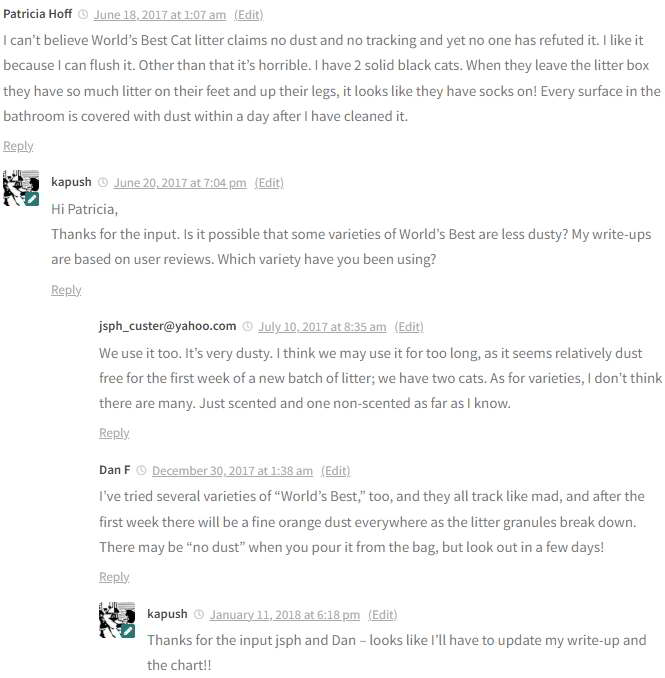
You can click here to view the comment thread.
It seems that the World’s best litter (pun intended), in addition to creating dust socks, also led a kitty to become so dusty that the poor thing had to be cleaned with baby wipes!
A lot of people do use dusty cat litter – probably because they find something particularly useful in them that outweighs the trouble.
However, dust that tracks all over the place and dust that you are forced to breathe in are two different kinds of trouble. It is not just respirable silica: any particulate matter that regularly goes inside our lungs will likely cause trouble. That’s trouble with a capital L – as in Long Term Trouble, and best avoided.
Until we come up with a separate article on the subject, please refer to this chart and take your pick of cat litter brands that are the least dusty.
5. Cat Litter That Does Not Track
Cat litter will track. It is a question of how much. Reviews indicate there are five natural cat litters that have minimal tracking:
- Naturally Fresh Walnut Cat Litter (formerly Blue Buffalo)
- Soft Paw Fuller’s Earth Cat Litter
- Feline Fresh Kiln Dried Reclaimed Pine Cat Litter
- SyLitter Corn and Cassava Cat Litter (formerly Garfield), and
- Only Natural Pet Non-GMO Grass Seed Cat Litter
You can view them in our comparison chart (in a post that discusses flushable cat litter).
If you have a favorite litter that doesn’t track much, please let us know in a comment.
6. Cat Litter With Great Odor Control
Okocat’s odor control lasts for up to seven days, reportedly. It is made from reclaimed wood and is an excellent litter overall (except for tracking).
Cat litter made of zeolite is usually good for odor control. Zeolite has a natural negative charge that attracts the positive ammonium ions in cat urine. This neutralizes the odor almost instantly. And, zeolite is extremely porous and absorbent. (Read more about zeolite as cat litter).
Natural pine absorbs odor and any cat litter made from pine ought to come with excellent odor control.
Amorphous Silica Gel cat litter like Pretty Litter absorb odor pretty well.
This attribute is this low down at number 6 because of three reasons:
- odor can be controlled by adding zeolite to your regular litter,
- it may be possible to keep the litter boxes / trays away from the main living area and,
- if you keep your litter box clean, odor alone is not likely to spread disease.
If your favorite litter does not have satisfactory odor control, please see if you find this zeolite litter aid helpful.
7. Best Litter for Declawed Cats or Post-Surgery
We do not support declawing cats because no matter what propaganda you may have heard of, it is mutilation, plain and simple. Declawing is cutting off part of their toe bones and leaving them with post-surgical trauma and extreme discomfort.
However, there are already too many declawed cats in shelters, and if you picked one to love and care for, you’re awesome! Now you will want to give them a litter that will not make the act of digging more challenging than it already is for a predator with their toes cut off.
Usually, pellets are best avoided. And common sense dictates that anything hard, grainy or sticky would be a source of serious discomfort. We’ll write a separate article on this but for now, here are a couple of choices generally known to be good for declawed cats:
Okocat Super Soft Unscented Wood Litter
SmartCat Unscented Grass Litter
For cats recovering from surgery, you’ll want something soft which will not stick to the wound when the bandage has been taken off. We are not talking about declawed cats, though. Nothing will be good for them until the physical wound has healed completely.
So, if you have a recently neutered feline, for example, paper pellets or soft granular litter – the kind that is neither dusty nor sticky, would be good.
Here are a few brands that you could try:
Okocat Dust Free Unscented Paper Litter
Fresh News Non-Clumping Scented Paper Litter
Marshall Ferret Virgin Paper Litter
This last one is obviously not made for cats, and we have not yet researched how sustainable their ‘Virgin’ paper litter production is but it looked like a viable option in a pinch. Especially since we’ve heard from our readers about how they’ve successfully used pellets made for other animals as cat litter.
8. Litter That Changes Color To Indicate Possible Sickness
This is certainly a matter of convenience. We’ve had comments about how this proved useful in the early detection and treatment of diseases.
At the moment, we know of two brands of cat litter that have this attribute.
Pretty Litter is a silica-based cat litter ‘with a proprietary health-indicating formula to help you monitor your cat’s urine for acidity and alkalinity levels outside the average range, plus the visible presence of blood’.
Pretty litter is lightweight and has superior odor control. And, it comes with a 30-day no questions asked full refund guarantee. So, you could probably give it a try and see if it is otherwise a good fit for your cat.
Sylitter has no such proprietary formula but claims to be whiter than most other litters. Made of corn and cassava, this one comes in small granules with good odor-control properties. It also clumps, and can still be flushed.
You may have used Sylitter when it used to come branded as Garfield cat litter. It was pretty popular back then, and Sylitter has successfully upheld the legacy. Visit the store locator to buy.
We also hope you never have the occasion to find out how well these two brands work to indicate sickness.
9. Flushable Cat Litter
Cat litter contains toxoplasma gondii, a parasite that harms ocean life. It is also harmful to pregnant women. This is the reason some states (like California) expressly forbid flushing of used cat litter.
Other than that, litter that is claimed to be flushable may well flush but then accumulate in the pipes and block the plumbing. In some cases, you have to flush only a small quantity at a time which is a huge waste of time and water.
But why is this attribute in our list of what the best litter for cats ought to be like? Well, the act of flushing used litter has one good consequence: you don’t add even more litter to landfills. And so, flushable cat litters are eco-friendly just because they are flushable (where allowed).
We have an entire article on flushable cat litter as well as one on frequently asked questions on the topic. Please feel free to browse both if you’re interested.
10. Certified Organic Cat Litter
Many years back, when organic simply meant something made from natural resources, we listed a number of cat litter brands that fitted that description.
Today, however, there could be objections if you’re using the term organic cat litter interchangeably with natural cat litter. To be organic, a litter needs to be certified by USDA-accredited authorities.
While this may seem like an overkill, certified organic does indicate an extra effort at using the best methods and materials so as not to hurt the earth any more than we already have.
We found only three certified organic brands of cat litter (which are all great choices).
The reason this attribute is so low down in our list is that as long as the litter is sustainably produced and is safe for cats and humans, we think it should be good enough. Not a lot of cat owners to our knowledge are finicky about using only certified organic litter and nothing else.
But if you are such a person (or if you are merely curious), please take a look at our article on organic cat litter brands.
If you want more choices, here are nine brands of cat litter made from natural resources with a non-profit brand among our best picks!
11. Biodegradable Cat Litter
While biodegradability is in any case a given with cat litter produced from natural resources, whether that is of any use depends on how you dispose of it.
Unless you are mixing it with your garden soil or composting the used litter, it will be dumped in a landfill. Even if you dispose of your used litter in paper or other biodegradable bags, stuffed inside a pile of hundreds, even thousands of packets doesn’t help with the decomposition process.
Even so, we’d much rather have a litter that degrades eventually than one that doesn’t. An exception would be amorphous silica gel cat litter. Silica is inorganic. The concept of biodegradability does not apply to it. But its composition is similar to the inorganic content naturally found in the soil. So it does actually become a part of the soil – which, for our purposes, is much the same as being biodegradable.
12. Compostable Cat Litter
We do realize that not everyone will bother to compost used litter. And that is why the attribute of being compostable is the lowest in our priority of what the best cat litter should be like.
Cat poop may contain toxoplasma gondii – a parasite harmful to marine life as well as to pregnant humans. If you’re going to compost used cat litter, it may be best to let it lie for 18 months at least before recycling it into your garden soil. This would be our recommendation even if you’re not using the compost to grow anything edible.
How do you compost used cat litter?
Composting is a huge subject that deserves its own article. We’ll give you a summary and should you be still interested in trying it out, please make use of the fact sheet and other resources we have linked to below.
Whether you are composting used litter in a bin or a hole dug in your garden, layer it alternately with some other material (e.g. organic kitchen waste).
- So, the first layer should be something like dry leaves and chopped branches or kitchen waste.
- The second layer is used litter.
- Cover this layer with any type of organic waste.
- Usually, the first and third layers should be at least as thick as the litter layer.
- And the litter layer should not be thicker than two inches in the bin and maybe four inches in a hole. You will want to experiment a little to see what works best.
- Sprinkle water after spreading out each layer to moisten it slightly.
- Close the lid of the bin / cover the mouth of the hole with tarpaulin or whatever water-resistant sheet you normally use for composting in your garden.
Depending upon the temperature (cold delays decomposition of any kind), you will have to overturn and mix the layers after a week or two. In particularly hot and humid areas, this can be done sooner. For bins, follow the instructions that came with it. If your bins are basically wooden boxes, make sure they are large enough and treat them like you’d the holes in your garden.
If you’re serious about composting, take a look at this fact sheet about composting dog poop. The same steps may apply to composting used cat litter. However, on page number one (footnote 2), you will find the following:
This study only included dog waste. Cat and other pet wastes were not studied. Cats may carry parasites that are harmful to human fetuses. We do not recommend adding cat waste or cat litter to your compost.
We have already talked about toxoplasma – which is what they are referring to when they mention ‘parasites…harmful to human fetuses’). There may be other parasites and germs as well. This is why, the only safe way to create used cat litter compost is through the hot composting method (which we have described). The heat generated in the process of composting ought to kill all pathogens and if you leave it aside long enough, it should be safe for home gardening.
Resources for further study:
Berkely 18-Day Hot Composting Method
So, what litter is best for cats?
We are not likely to find all of these attributes in a single brand of cat litter, but hopefully, all that we’ve written will act like a checklist while you decide what litter is the best for your cat – and the world in general.
Prioritizing helps, and in our list, we prioritized along what we thought were the most sensible parameters: keep the world unharmed while our kitties do their business.
If you found the write-up useful, please share it with other cat people you know!
And we’d love to have your comments and feedback, as always.
Thank you for visiting Kapush | Cat Litter.

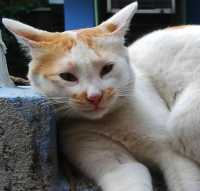

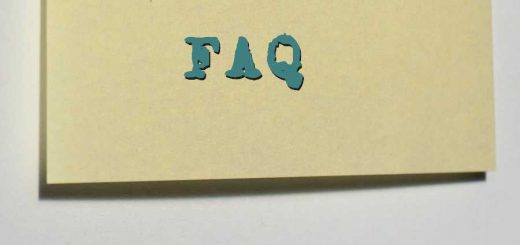
It’s great that you pointed out how certified organic does indicate an extra effort at using the best methods and materials so as not to hurt the earth any more than we already have. We just bought a new pet cat, so we need to buy litter for it. We do not want to use something artificial or toxic, so we are thinking of using organic cat litter.
Looking forward to writing on your product – let us know the details of your manufacturing process with some documentation. No remuneration required – we are happy to list the most cat-friendly products for our readers.